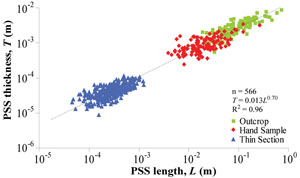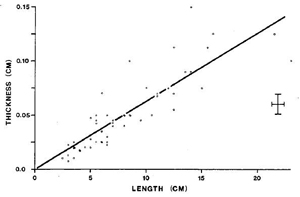| |||||||||
|
|
|||||||||
|
|
|||||||||
| Pressure Solution Seam Thickness - Length Scaling | |||||||||
|
Since the pioneering work by Stockdale (1922), it has been well known that PSS thickness is a measure of the insoluble components in dissolving rock volume and is therefore proportional to the closure across the structure. Figure 1 shows a plot of thicknesses versus lengths of PSSs in sandstone measured in thin section, hand sample, and at outcrop (Nenna and Aydin, 2011; Nenna et al., submitted). This plot indicates that PSS thickness and length are proportional with the approximate power-law relationship T = 0.013L to the power of 0.70 within the observed range.
On the other hand, Mardon (1988) found a linear relationship of T=0.006L for stylolitic PSSs in limestones as shown in Figure 2.
Either in power or linear form, the proportional thickness-length relationship has implications for the growth of PSSs as well as their mechanics. See Nenna and Aydin (2011). | |||||||||
| Reference: |
|||||||||
| Mardon, D., 1988 Nenna, F., Zhou, X., Aydin, A., 2012 Stockdale, P.B., 1922 |
|||||||||
|
Readme | About Us | Acknowledgement | How to Cite | Terms of Use | Ⓒ Rock Fracture Knowledgebase |
|||||||||

